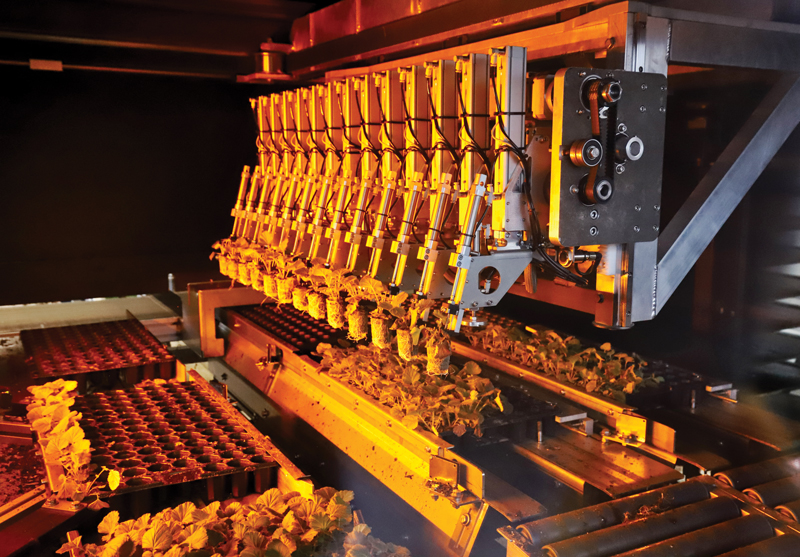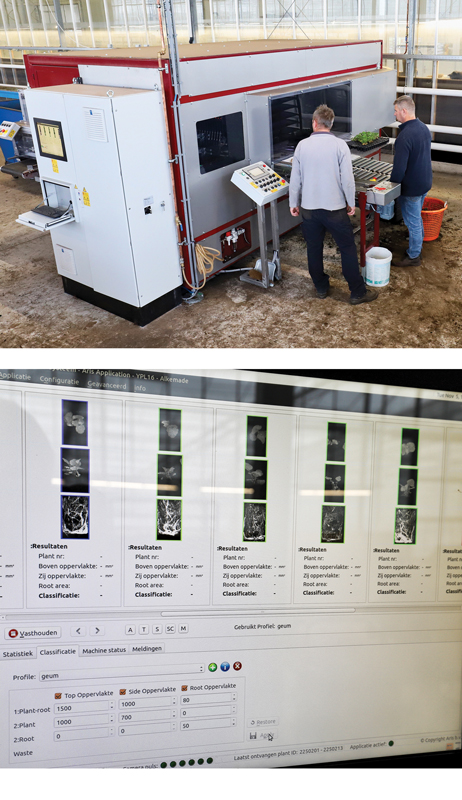12/1/2019
Root Cause
Chris Beytes

There’s nothing new (at least in high-tech greenhouses) about using cameras and computers to grade and sort plugs and cuttings. What is new is analyzing pictures of the root zone, as well as the green portion of the plant, as is happening in this photo of a new Young Plant Sorter from Dutch equipment specialist Flier Systems (represented by AgriNomix in North America). GrowerTalks saw it in action in November at perennial liner grower Gebr. Alkemade in Lisse, the Netherlands.
The machine was originally developed for the tomato young plant business. Alkemade’s owners, Theo and Wil Alkemade, thought it could help them reduce labor, save space and improve the quality of the 25 million perennial liners they sell annually.
 Why grade and why the roots? Alkemade grows more than 1,000 varieties of perennials in several dozen genera, almost all from cuttings, in about 300,000 sq. ft. of greenhouse. Cuttings that don’t root or are smaller than desired can waste a lot of that expensive space, so grading and sorting is essential. Done by hand, it’s slow and labor-intensive, requiring upwards of 30 people during peak times.
Why grade and why the roots? Alkemade grows more than 1,000 varieties of perennials in several dozen genera, almost all from cuttings, in about 300,000 sq. ft. of greenhouse. Cuttings that don’t root or are smaller than desired can waste a lot of that expensive space, so grading and sorting is essential. Done by hand, it’s slow and labor-intensive, requiring upwards of 30 people during peak times.
Flier’s Young Plant Sorter lets Alkemade grade early in the production process—as soon as three to four weeks after sticking, thanks to the use of Growcoons as their rooting container (it holds the root ball together until it has developed).
The machine’s cameras look at three things: The top of the plant (looking down), the side view of the plant and the side view of the roots. The grower inputs how much of each they want and the machine then sorts into three grades—you might call them best, good and trash. All the best liners go together into one tray, the good liners go into another tray and both lots go into the greenhouse for growing on. Trash obviously goes into the trash. The inset photo (left) shows the three views the camera gets.
Early in the process, they grade by looking at the top of the plant, just to see if it has survived. Later on, they can grade by the green portion and the root system.
Being able to grade the roots is important because many perennial genera will develop good roots first, while still having little green growth. Those varieties can get sorted with good roots as a priority.
The machine does it all with 13 grippers and three Aris cameras. Speed is optimized at 8,000 plants per hour, although workers Marius van Duijn and Marco van Delft who were setting up the machine told us they’ve hit 9,500. And the machine was just four weeks old when we saw it at work. The desired outcome? “If [waste] is below 10%, that’s good,” said Marius. GT